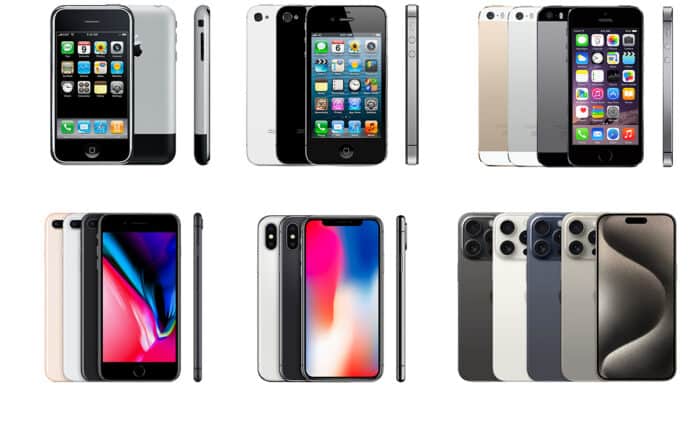Apple released the first iPhone in June 2007. Since then, the company has released 28 different iPhone models year after year. Throughout nearly those two decades, Apple has not failed to introduce groundbreaking features within the latest device.
Here’s how the iPhone has evolved as the most desirable smartphone thanks to its software upgrades and hardware redesigns throughout its lifetime.
All iPhone models in order:
Original iPhone 2G – 2007

- Release date: June 29, 2007
- Model: A1203
- Storage capacity: 4GB, 8GB, 16GB
- Major features: Modern design, multi-touch, no physical keyboard, easy-to-use user interface
At the time of its release, the original iPhone lacked many standard features such as 3G, copy and paste, multitasking, or even sending a simple MMS. Even worse, you could not record videos with such an awesome, revolutionary device. This did not stop the iPhone from becoming the smartphone that paved the road for future smartphone development.
The iPhone was revolutionary because it was completely different from your typical smartphone of the era. It was the first phone with a multi-touch screen and an easy-to-use interface. Additionally, it got rid of those ugly and bulky physical keyboards, and users now had to use a digital QWERTY keyboard.
iPhone 3G – 2008
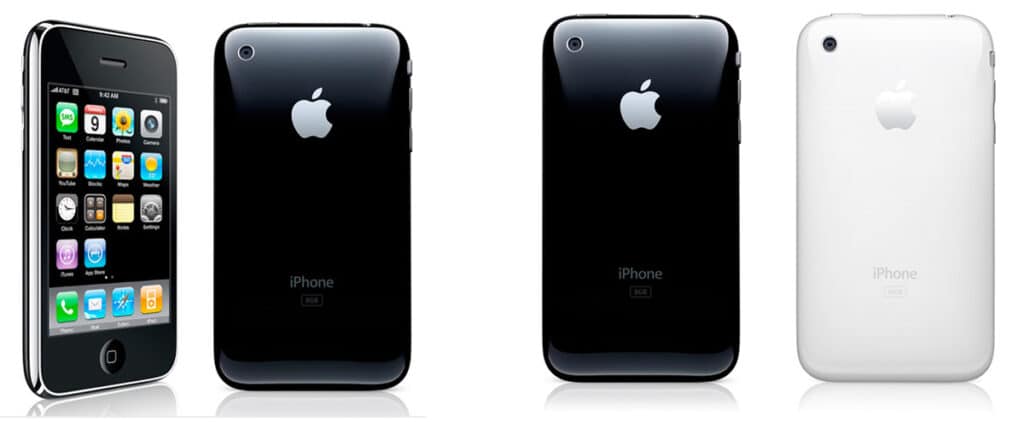
- Release date: July 11, 2008
- Models: A1241, A1324
- Storage capacity: 8GB, 16GB
- Major features: App Store, 3G support, GPS, MobileMe (now iCloud), talking & web browsing simultaneously, iPhone OS 2.0
When the original iPhone was released, one of its biggest complaints was the lack of 3G support. With the release of the iPhone 3G the following year, Apple made everything about 3G. 3G data speeds loaded web pages up to three times faster than 2G (EDGE).
Another major feature introduced with the iPhone 3G was the App Store. The iPhone 3G was also the first iPhone model produced in multiple colors. It was produced in black and white colors.
Although 3G and the App Store might appear as a big deal, the iPhone 3G felt like an incremental upgrade of the original iPhone. This is because iPhone 3G users crippled AT&T’s 3G network and made the whole network slow.
Also, since the App Store was new, it did not have that many quality apps that took advantage of the iPhone 3G hardware.
iPhone 3GS – 2009

- Release date: June 19, 2009
- Models: A1325, A1303
- Storage capacity: 8GB, 16GB, 32GB
- Major features: Video recording, 3-megapixel autofocus camera, copy and paste, MMS, 7.2 Mbps HSDPA network speeds, compass, Find My iPhone, iPhone OS 3.0
Although it retained the original iPhone’s design, the iPhone 3GS was Apple’s first iPhone that felt like a huge upgrade. Hardware and software-wise, the iPhone 3GS was a major upgrade over the iPhone 3G.
Apple claimed that the new iPhone 3GS performed twice as fast as the iPhone 3G, hence the added “S,” which stands for “Speed.” Also, since users could now record video, Apple introduced a 32GB version of the iPhone.
With the iPhone OS 3, Apple finally caught up with other smartphone manufacturers on the iPhone 3GS in terms of software features. Thanks to the iPhone OS 3, the iPhone 3GS gave iPhone users basic, long-waited features such as video recording, MMS, copy and paste, voice control, and Spotlight Search.
The iPhone 3GS also introduced a feature that symbolizes the iPhone today: Find My iPhone. This feature lets the owner locate their expensive iPhone, play a sound, or send a message to anyone who finds the device.
iPhone 4 – 2010
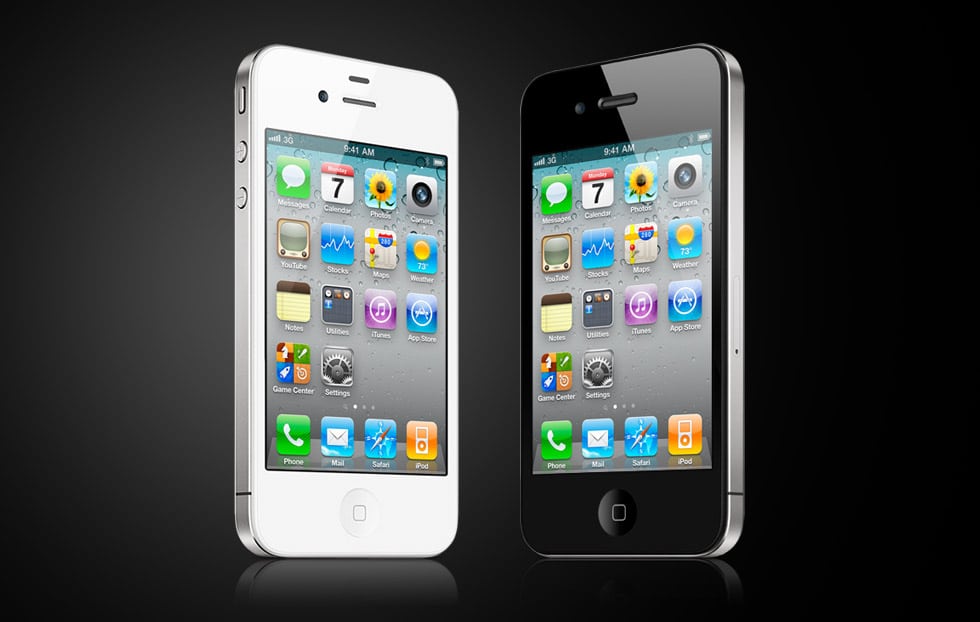
- Release date: June 24, 2010
- Models: A1349, A1332
- Storage capacity: 8GB, 16GB, 32GB
- Major features: Completely redesigned iPhone, 5-megapixel camera, Facetime video calling, Retina display, HD video recording, multitasking, iOS 4
The iPhone 4 was the phone that set in stone what a modern smartphone should look and function from that time on. It was Apple’s first redesigned iPhone since the launch of the original iPhone.
The iPhone 4 was packed with revolutionary features and hardware changes, making it impossible for older iPhone owners to resist upgrading. Also, the phone made Apple obsessed with making the iPhone thinner each year.
The most impressive work of the iPhone 4 was its new redesign. Apple made the iPhone thin and built it out of glass and stainless steel.
With the iPhone 4, Apple introduced the Retina display, Apple’s marketing term for a high-resolution screen.
Apple released the iPhone 4 with iOS 4, which included many features never seen before in a smartphone. iPhone users could now video chat seamlessly with each other thanks to Facetime. The OS and the upgraded internal hardware also allowed iPhone 4 users to switch between apps easily.
After all, although the iPhone 4 is one of Apple’s most groundbreaking phones, this phone has also been one of Apple’s most controversial products.
Months before the device was announced, an Apple engineer lost a prototype of the iPhone 4 at a bar. Leaked photos of this prototype ended up all over the web. Another major PR problem the iPhone 4 had was that users reported drop reception when holding the iPhone tightly or covering the metal band.
Apple replied that this was because users were holding the iPhone 4 wrong. This is when the You’re Holding It Wrong (iPhone Death Grip) meme became popular.
The iPhone 4 was the last product Steve Jobs introduced before dying the following year, nine days before the iPhone 4S was released.
iPhone 4S – 2011

- Release date: October 14, 2011
- Models: A1431, A1387
- Storage capacity: 8GB, 16GB, 32GB, 64GB
- Major features: dual-core A5 chip, Siri, 1080p video recording, 8-megapixel camera, iCloud, iMessage, world phone (CDMA + GSM radio/antenna), 14.4 Mbps HSDPA speeds, iOS 5
Like going from an iPhone 3G to a 3GS, the big changes from the iPhone 4 to the iPhone 4S were mostly done on the software update. Besides the upgraded A5 chip and other small changes, internal hardware mostly stayed the same. The big deal on the iPhone 4S was iOS 5.
iOS 5 was an OS upgrade that introduced some of the most widely used features today by iPhone users worldwide. In iOS 5, Apple introduced iMessage, Siri, and iCloud. These are three core features of the iPhone today.
On the hardware side of the iPhone, the iPhone 4S was the first iPhone to be a world phone. This meant an iPhone unit could be used on a GSM or CDMA network.
Sprint and Verizon mostly ran the obsolete CDMA networks at that time. GSM users (AT&T) now had 14.4 Mbps HSDPA speeds with the iPhone 4S.
Additionally, since the iPhone could now record 1080p videos, Apple introduced a 64GB model of the iPhone 4S.
iPhone 5 – 2012

- Release date: September 21, 2012
- Models: A1428, A1429, A1442
- Storage capacity: 16GB, 32GB, 64GB
- Major features: A6 chip, bigger screen, new aluminum redesign, 4G LTE and DC-HSDPA, 802.11n Wi-Fi, HD front Facetime camera, new Lightning connector, new Apple EarPods, nano-SIM card, iOS 6
Unlike the iPhone 4 to 4S upgrade, the significant upgrades from the iPhone 4S to the five were found in the hardware, not the software update.
The iPhone 5 was redesigned with an aluminum body and a 4-inch screen. The screen was bigger than all previous 3.5-inch screens in previous iPhone models.
The A6 chip significantly increased the performance of the iPhone 5. On top of that, Apple made significant upgrades in network connectivity. The iPhone 5 supported 4G LTE and faster HSDPA speeds for users on GSM carriers. The iPhone 5 could now also be connected to 5ghz WiFi networks.
Another huge hardware change was that Apple introduced the new Lightning connector, replacing the old 30-pin connector. Your old iPhone charger/cable from your previous iPhone would not work on the iPhone 5 unless you purchased a Lightning-to-30-pin Adapter.
iPhone 5s – 2013
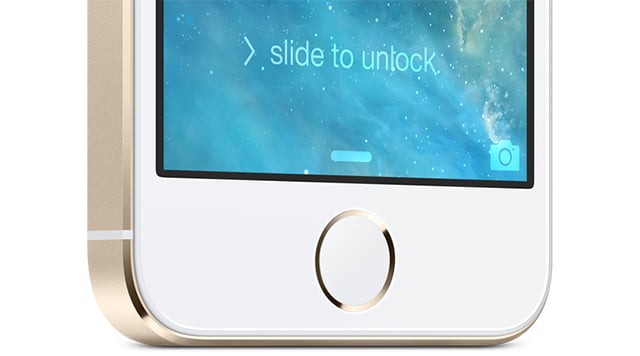
- Release date: September 20, 2013
- Models: A1453, A1457, A1518, A1528, A1530, A1533
- Storage capacity: 16GB, 32GB, 64GB
- Major features: 64-bit A7 chip, Touch ID Fingerprint Sensor, 8-megapixel iSight camera, M7 motion coprocessor, iOS 7
With the same body as the iPhone 5, Apple introduced two major upgrades with the iPhone 5s. The iPhone 5s was now powered by a 64-bit desktop processor, which embarrassed and blew competitors out of the water. This new chip architecture made the iPhone 5s perform twice as fast as the iPhone 5.
Another big feature introduced in the iPhone 5s was Touch ID. Touch ID lets you secure your iPhone with your fingerprint by using the fingerprint sensor built-in on the home button.
Passcodes became a thing of the past. Like Face ID now, Touch ID lets you secure user names and passcodes across apps and websites.
iPhone 5c – 2013
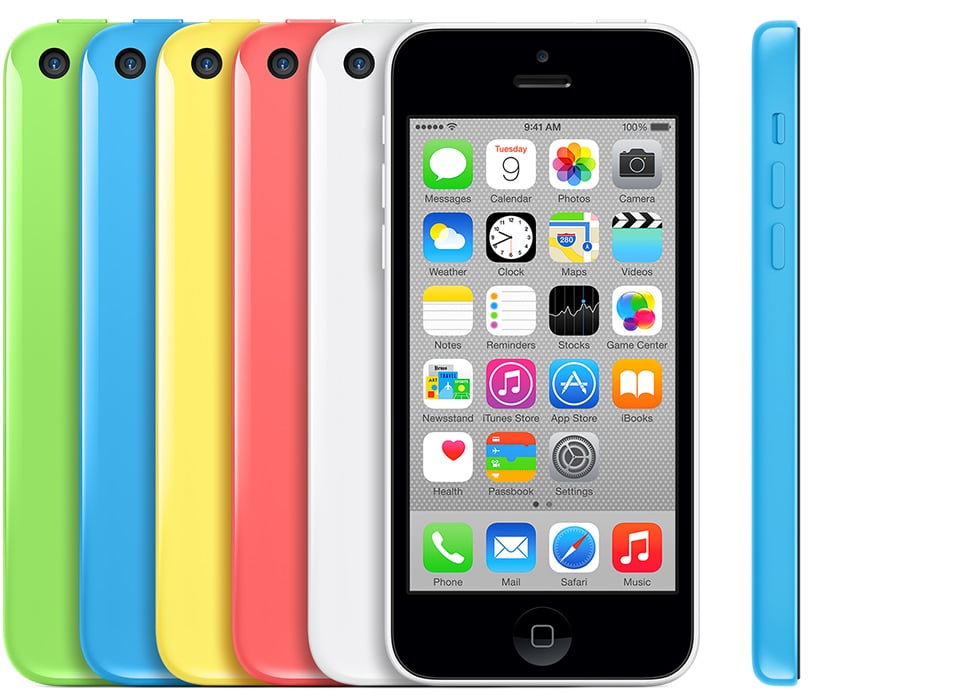
- Release date: September 20, 2013
- Models: A1456, A1507, A1516, A1529, A1532
- Storage capacity: 16GB, 32GB
- Major features: Five colors, plastic shell, low-budget iPhone
In 2013, Apple released two different iPhone models at an event for the first time. Apple released the iPhone 5c along with the iPhone 5s. The iPhone 5c was something unexpected from Apple because Apple has never catered to the low-budget demographic on computers or the cell phone market.
The iPhone 5c had the same internal hardware as the iPhone 5. The only difference was that it was offered in five colors and was built in a plastic outer shell.
This was different from the aluminum, glass, and steel Apple had built previous iPhones, which made them look luxurious and high-end.
Apple stopped production of the iPhone 5c in 2015 and has since added it to the list of obsolete products.
iPhone 6 & iPhone 6 Plus – 2014
After releasing two different iPhone models at the time, the iPhone 5s and 5c, Apple did the same thing the following year. This time, the company unveiled the iPhone 6 and 6 Plus during its 2014 September event. The iPhone 6 and 6 Plus sold 3,333,333 units within 24 hours; the original iPhone only sold 13,513 units within 24 hours of release.
iPhone 6
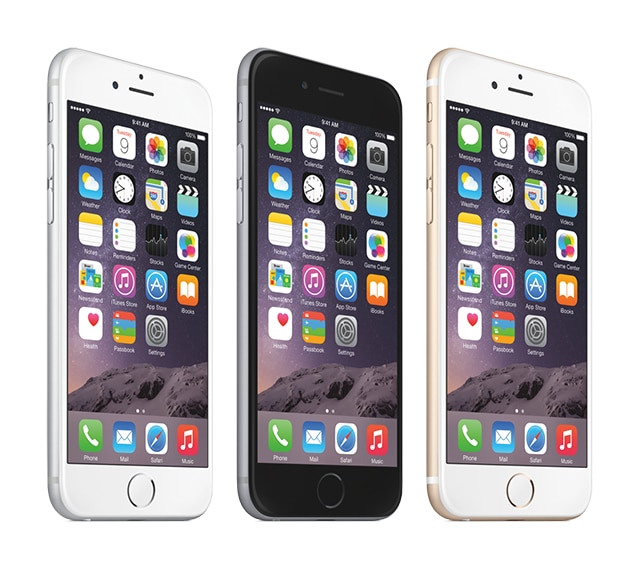
- Release date: September 19, 2014
- Models: A1549, A1586, A1589
- Storage capacity: 16GB, 32GB, 64GB, 128GB
- Major features: Thinner than ever, A8 chip, 4.7-inch Retina display, unibody design, Apple Pay, M8 motion coprocessor, VoLTE, Wi-Fi calling, Bluetooth 4.0, 1,810 mAh battery, iOS 8
The iPhone 6 is the iPhone that Apple fans were thankful to Samsung. While the world was moving to phones with bigger screens, Apple insisted that smaller screens offered better usability.
Even in 2013, Samsung packed a 5-inch screen in their Galaxy S4. Later the same year, Apple released its flagship, the iPhone 5s, with just a 4-inch display. Steve Jobs even once said that no one would buy a phone with a bigger screen.
Apple’s response to customers wanting a bigger screen was a 4.7-inch display with the iPhone 6. Apple did not just make a taller iPhone 5s; the company redesigned it again and called it the “biggest advancement in iPhone history.”
The iPhone 6 also introduced voice-over LTE (VoLTE). This allowed you to simultaneously talk and browse the web while connected to an LTE network. The iPhone also introduced Apple Pay, an essential feature for iPhone users today.
iPhone 6 Plus

- Release date: September 19, 2014
- Models: A1522, A1524, A1593
- Storage capacity: 16GB, 64GB, 128GB
- Major features: 5.5-inch Retina HD display, optical image stabilization, 2,915 mAh battery, thinner than ever, A8 chip, 4.7-inch Retina display, unibody design, Apple Pay, M8 motion coprocessor, VoLTE, Wi-Fi calling, Bluetooth 4.0, 1,810 mAh battery, iOS 8
With the iPhone 6 Plus, Apple granted their wish to iPhone users anxiously waiting for an iPhone with a bigger screen.
Instead of creating two completely different iPhone models like Samsung did with the Galaxy Note and the regular Galaxy S lineup, Apple made it simple and just made the regular iPhone 6 and the iPhone 6 Plus.
The iPhone 6 Plus was nearly identical to the iPhone 6. The biggest difference was its bigger 5.5-inch screen size compared to the 4.7-inch screen size of the regular iPhone 6. Also, the iPhone 6 Plus had a bigger battery than the iPhone 6, which made it last longer.
iPhone 6s & iPhone 6s Plus – 2015
iPhone 6s
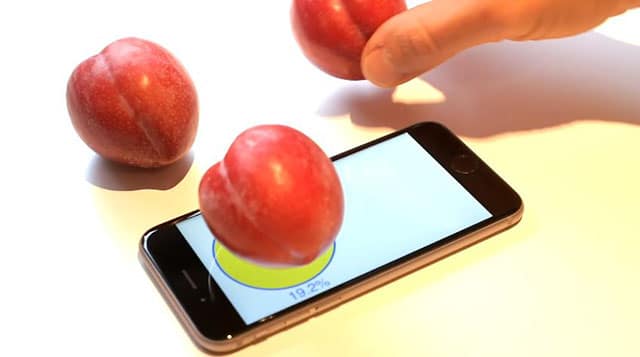
- Release date: September 25, 2015
- Models: A1633, A1688, A1700
- Storage capacity: 16GB, 32GB, 64GB, 128 GB
- Major features: 3D Touch, A9 chip, 12-megapixel camera, improved Touch ID, Live Photos, 4K video recording, M9 motion coprocessor, iOS 9
Although the iPhone 6s felt more polished and ran smoother than the iPhone 6s, it did not feel as big as other “S” cycle upgrades.
The iPhone 6s made people realize that Apple was extremely greedy with storage. Apple was still selling the base model with 16GB of storage even though the iPhone could now shoot 4k videos.
Apple also introduced a new feature called 3D Touch. This feature lets you long press the screen of the iPhone for quick options or the equivalent of a right-click on a computer mouse.
Developers quickly started getting creative with 3D Touch. One of them even turned the iPhone 6s into a weight. Apple later killed 3D Touch, starting with the iPhone 11.
iPhone 6s Plus
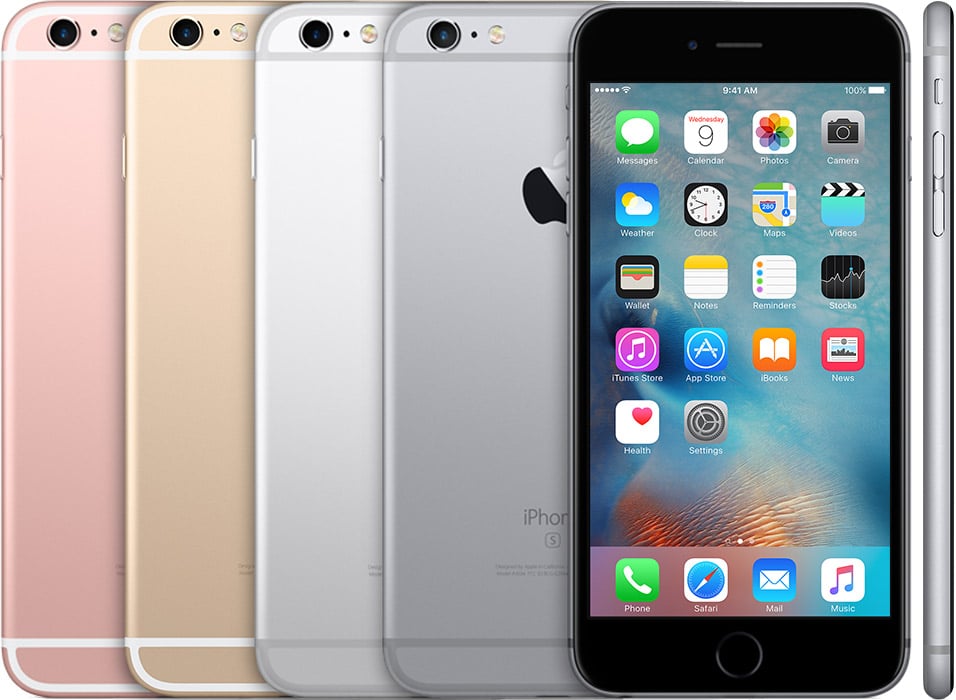
- Release date: September 25, 2015
- Models: A1634, A1687, A1699
- Storage capacity: 16GB, 32GB, 64GB, 128 GB
- Major features: Optical image stabilization for videos, 2750 mAh battery, 3D Touch, A9 chip, 12-megapixel camera, improved Touch ID, Live Photos, 4K video recording, M9 motion coprocessor, iOS 9
The iPhone 6s and iPhone 6s Plus do not have any major differences other than the screen and battery size.
iPhone SE (1st generation) – 2016
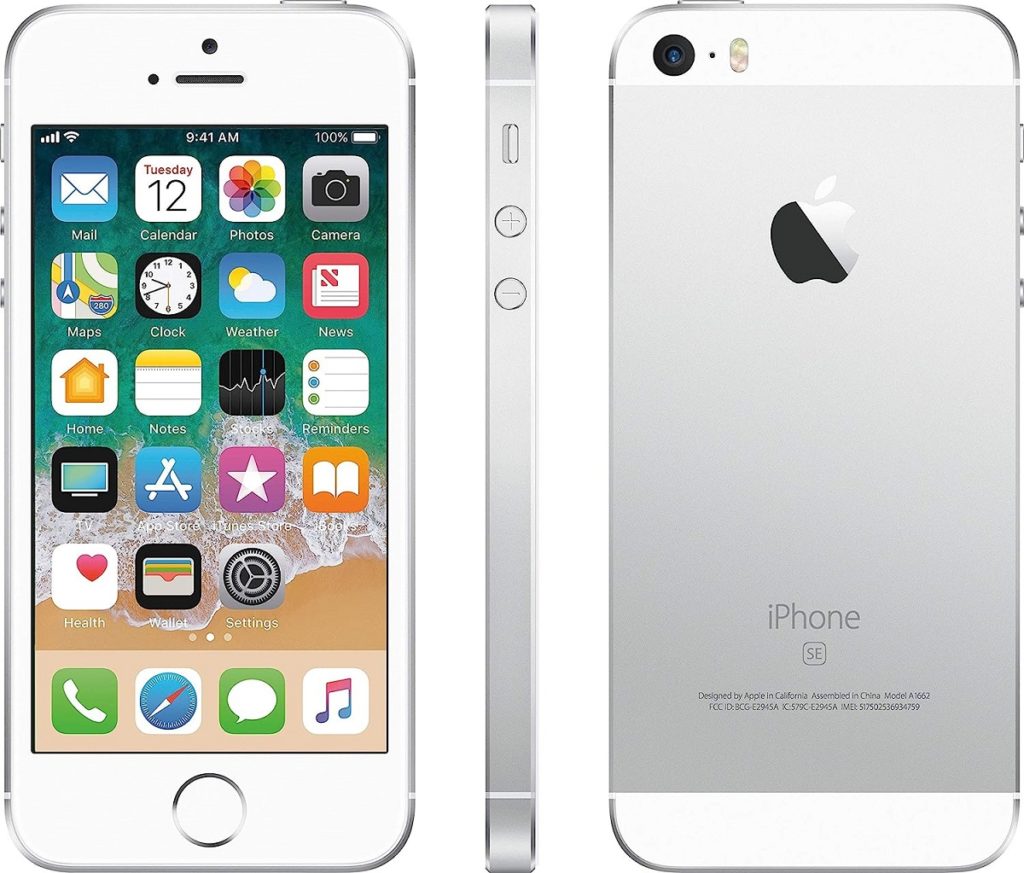
- Release date: March 31, 2016
- Models: A1723, A1662, A1724
- Storage capacity: 16GB, 32GB, 64GB, 128 GB
- Major features: 4-inch screen, A9 chip, 12-megapixel iSight Camera, Live Photos, 4K video recording, Touch ID, Apple Pay
Although Apple killed the iPhone 5c in 2015, it did not abandon that market. Apple introduced the iPhone SE in 2016 for those wanting an entry-level iPhone or those who still prefer phones with a smaller screen.
The iPhone SE is an iPhone 6s in an iPhone 5s body. For the most part, the iPhone SE has the same performance as the iPhone 6s. Only a few minor features in the iPhone 6s are unavailable in the iPhone SE. These features are 3D Touch, 2nd-gen Touch ID, and a 4.7-inch screen.
iPhone 7 & iPhone 7 Plus – 2016
The iPhone 7 and 7 Plus were Apple’s first water- and dust-resistant iPhones. It also introduced the AirPods, making the 3.5 mm headphone jack obsolete.
iPhone 7

- Release date: September 16, 2016
- Models: A1660, A1778, A1779
- Storage capacity: 32, 128, 256 GB
- Major features: A10 Fusion chip, stereo speaker system, water and dust resistance, new 12-megapixel camera system, 7-megapixel FaceTime HD camera, Quad-LED True Tone flash, 4G LTE Advanced, Taptic Engine, no 3.5 mm headphone jack, solid-state Home button, new Jetblack color, iOS 10
While it had a similar design to the iPhone 6s, the iPhone 7 had many changes and hardware improvements. One of the major changes in the iPhone 7 that most people were not happy about was the removal of the 3.5 mm headphone jack.
People theorized that Apple removed the headphone jack to sell their newly introduced AirPods. That’s why we no longer see a headphone jack in our smartphones today.
Apple engineer Dan Riccio later explained during an interview with BuzzFeedNews that the headphone jack was removed because that space was needed for the processor, battery, and the new camera system.
The engineer further explained that the headphone jack prevented the iPhone from meeting the IP67 water resistance standard.
The iPhone 7 was also the phone that made Apple realize that they were being greedy with storage capacity. Apple removed the 16GB model, and 32GB became the base model.
iPhone 7 Plus
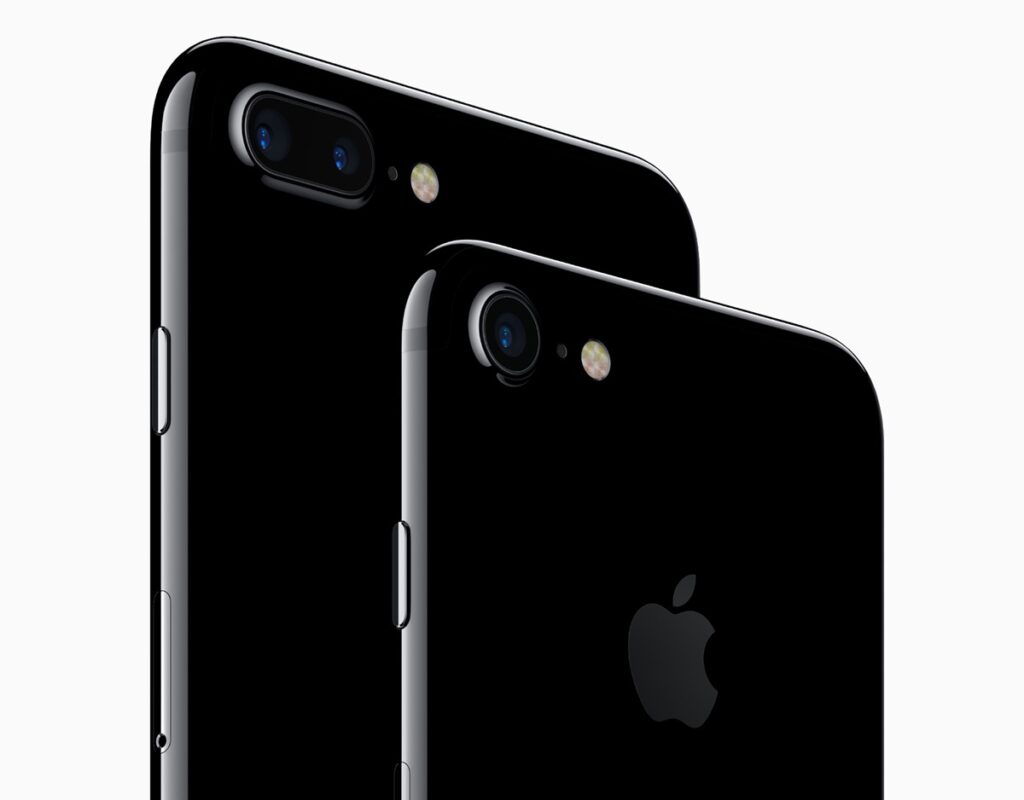
- Release date: September 16, 2016
- Models: A1661, A1784, A1785
- Storage capacity: 32, 128, 256 GB
- Major features: 2x optical zoom, 10x digital photo zoom, A10 Fusion chip, stereo speaker system, water and dust resistance, new 12-megapixel camera system, 7-megapixel FaceTime HD camera, Quad-LED True Tone flash, 4G LTE Advanced, Taptic Engine, no 3.5 mm headphone jack, solid-state Home button, new Jetblack color, iOS 10
Besides the size, the iPhone 7 Plus has no major feature over the iPhone 7. The only major difference is that the iPhone 7 Plus has 3GB of RAM while the iPhone 7 only has 2GB.
iPhone 8 & iPhone 8 Plus – 2017
First iPhone with wireless charging capability and designed for augmented reality.
iPhone 8
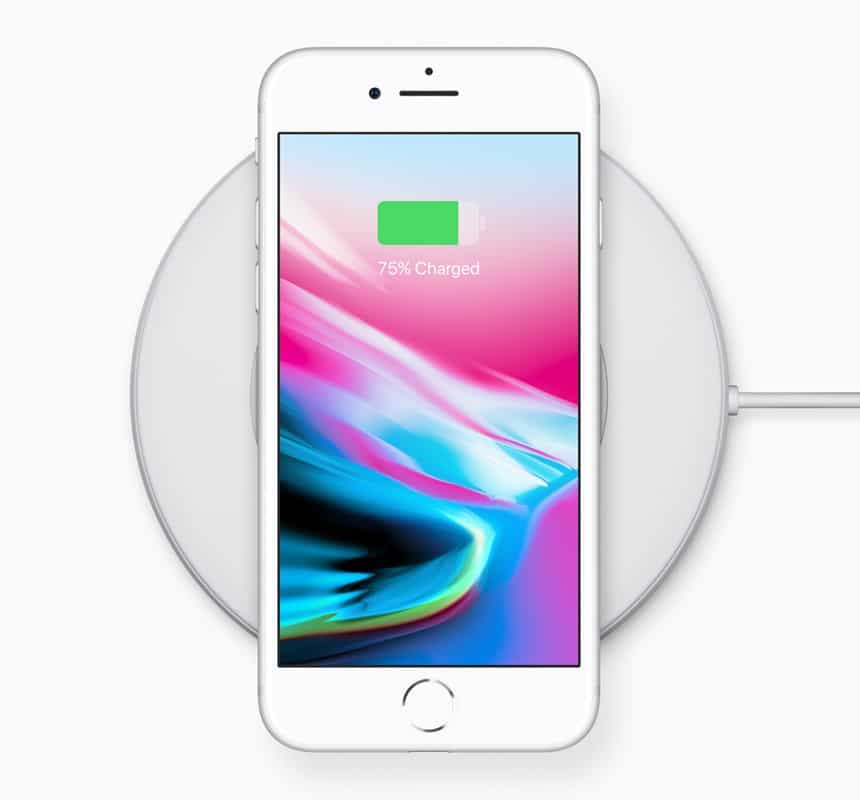
- Release date: September 22, 2017
- Models: A1863, A1905, A1906
- Storage capacity: 64, 128, 256 GB
- Major features: A11 Bionic chip, wireless charging, new design, AR optimization, redesigned stereo speakers, 1080p slo-mo @ 240fps, iOS 11
Apple made an unexpected move with the release of the iPhone 8. Before the iPhone 8 announcement, people were expecting an iPhone 7s. The company instead skipped the iPhone 7s and jumped straight to the iPhone 8.
While Apple never confirmed why they skipped the iPhone 7s, many people speculated that this was a marketing strategy. As for the changes, the iPhone 8 brought wireless charging and was designed for augmented reality (AR), which was gaining popularity back then.
The back of the iPhone 8 was now made of glass instead of aluminum to facilitate wireless charging.
With the iPhone 8, Apple continued increasing the base model’s storage capacity. This time, they replaced the 32GB with 64GB as their base model.
iPhone 8 Plus
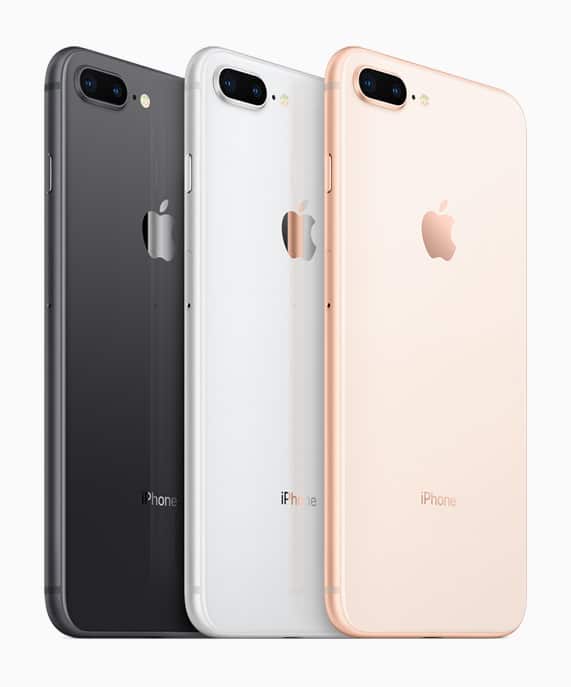
- Release date: September 22, 2017
- Models: A1864, A1897, A1898
- Storage capacity: 64, 128, 256 GB
- Major features: Portrait Lighting, Dual 12MP Wide and Telephoto cameras, A11 Bionic chip, wireless charging, new design, AR optimization, redesigned stereo speakers, 1080p slo-mo @ 240fps, iOS 11
The major difference between the regular iPhone 8 and the iPhone 8 Plus, other than size and battery life, is in the camera system. While both phones sport a 12-megapixel camera, the 8 Plus now has a second telephoto camera, allowing you to take portrait shots with depth-of-field and studio lighting effects to portrait photos.
Additionally, you can digitally zoom photos up to 10x on the 8 Plus, compared to just 5x on the regular iPhone 8. The iPhone 8 Plus camera is built with a 2x optical zoom lens.
iPhone X – 2017

- Release date: November 3, 2017
- Models: A1865, A1901, A1902
- Storage capacity: 64GB, 256 GB
- Major features: Face ID, 5.8-inch OLED screen, TrueDepth Camera System, A11 Bionic Chip, dual optical image stabilization, all-screen display, Dolby Vision, HDR10, kills Home button, Portrait mode for front camera, dual optical image stabilization, customized cameras for augmented reality, 4K video up to 60fp, 1080p slo-mo up to 240fps, Animoji, iOS 11
The iPhone X was Apple’s biggest iPhone upgrade since the iPhone 4. Apple did not announce an iPhone 8s or an iPhone 9. Instead, to celebrate the iPhone’s 10th anniversary, Apple released the iPhone X (10) along with the iPhone 8.
Apple completely redesigned the iPhone X and brought technologies never seen on a mobile device. Apple introduced Face ID, which replaced Touch ID. The newly designed iPhone was now built with a 5.8-inch OLED screen that Apple called Super Retina display.
Apple replaced the Home button on the iPhone X with on-screen gestures.
On the controversial side, an engineer got fired from Apple because his daughter made a video demonstration of the device before it was released. The iPhone X was also heavily criticized for how easy it was to break and how expensive repairs were.
iPhone Xr – 2018
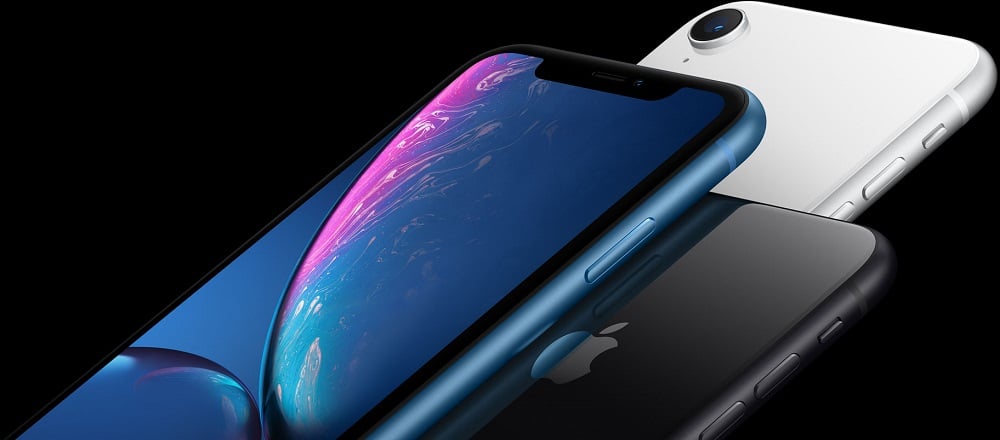
- Release date: October 26, 2018
- Models: A1984, A2105, A2106, A2107, A2108
- Storage capacity: 64GB, 128GB, 256 GB
- Major features: Edge-to-edge 6.1-inch Liquid Retina display, A12 Bionic chip, Next-generation Neural Engine, faster Face ID, 7-nanometer A12 Bionic chip, Portrait mode and Portrait Lighting photos, Dual SIM, eSIM, iOS 12
In 2018, Apple continued what it started in the previous year’s event: they released a regular iPhone and a premium version of the iPhone.
This time, Apple announced the iPhone Xr (regular iPhone) and a premium model of the iPhone, the iPhone Xs.
Although the iPhone Xr was announced along with a premium model (iPhone Xs), the iPhone Xr is not a budget phone by any means. The iPhone Xr is the successor to the iPhone 8, packed with many high-end features found in the iPhone X and even more.
The iPhone Xr was now packed with a 6.1 edge-to-edge display. The Xr was Apple’s first device to be released with a Liquid Retina display. Today, iPhones no longer use physical SIM cards. This was something that started with the iPhone Xr in 2018.
Thanks to the introduction of eSIM, the iPhone Xr could now use two different carriers simultaneously. This could be done by combining a physical nano-SIM and a digital eSIM. Apple also improved Face ID in the iPhone Xr for faster authentication.
The only thing people did not like about the phone was the 720p screen instead of 1080p. Its predecessor, the iPhone 8 Plus, has a smaller screen (5.5-inch) but has a 1080p screen.
iPhone Xs & iPhone Xs Max – 2018
Along with the iPhone Xr in September 2018, Apple announced the iPhone X successors: the iPhone Xs and Xs Max.
With these two models, Apple stopped using the term “Plus” to name their bigger screen model. Instead, Apple started naming its bigger screen iPhone as “Max.”
iPhone Xs
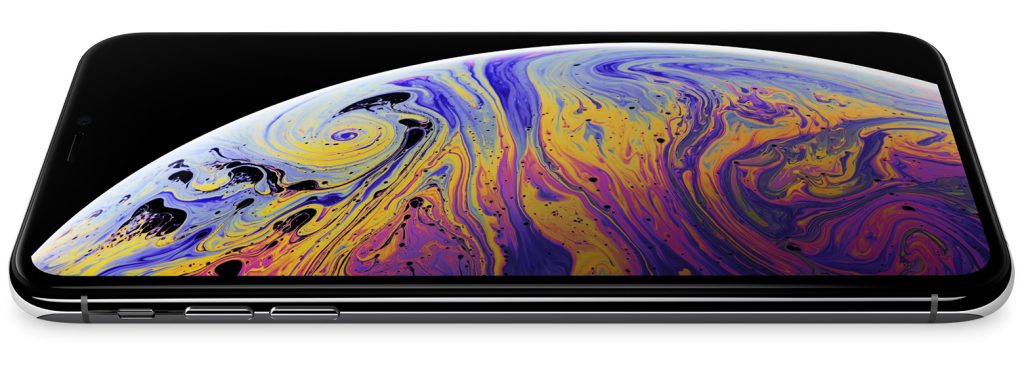
- Release date: September 21, 2018
- Models: A1920, A2097, A2098, A2099, A2100
- Storage capacity: 64GB, 256GB, 512GB
- Major features: Improved dual camera system, OLED screen with HDR, faster wireless charging, IP68 splash and water resistance, LTE-Advanced Pro (Gigabit-Class LTE), iOS 12
The iPhone Xs is an iPhone X with all the hardware improvements of the iPhone Xr and some new features.
The iPhone Xs has the same design as the iPhone X. It has all the features Apple introduced in the iPhone Xr with even bigger improvements and features. These features include LTE-Advanced Pro, IP68 water resistance, and faster wireless charging.
Additionally, the iPhone Xs sports a 5.8-inch 1080p OLED display. The iPhone Xr has a bigger LCD 6.1-inch display but with 720P resolution.
As for storage, Apple added a 512GB model of the iPhone Xs and eliminated the 128GB model.
iPhone Xs Max
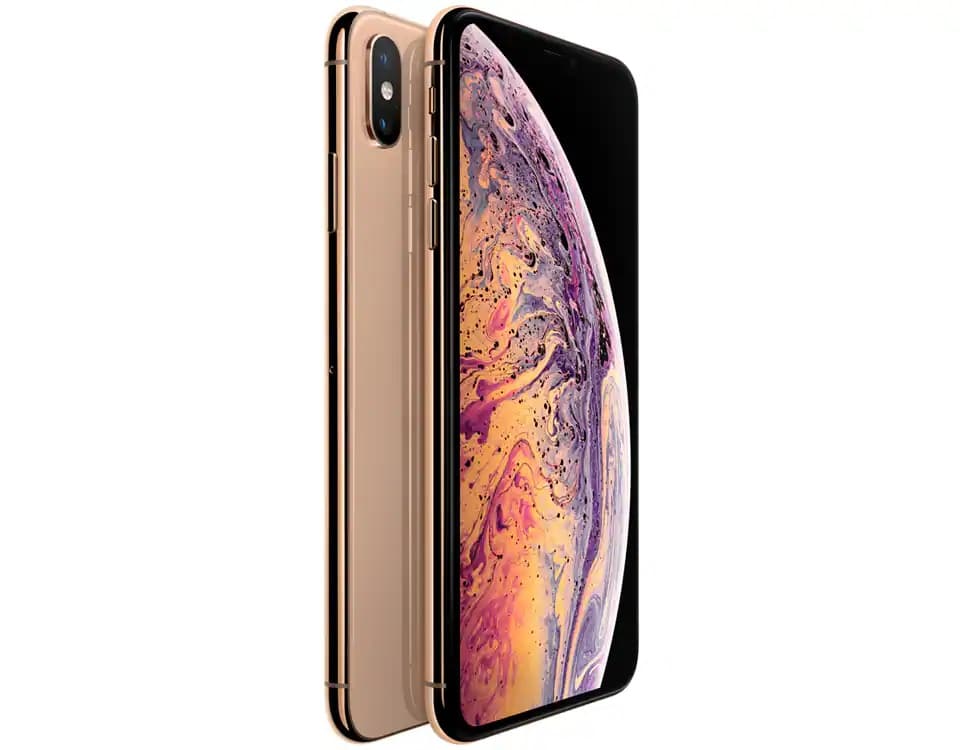
- Release date: September 21, 2018
- Models: A1921, A2101, A2102, A2103, A2104
- Storage capacity: 64GB, 256GB, 512GB
- Major features: 6.5‑inch OLED display with 2436‑by-1125‑pixel resolution at 458 ppi
The iPhone Xs Max does not have significant improvements over the regular iPhone Xs. The only big difference is in its battery and screen size. The iPhone Xs has a 2658mAh battery, while the Xs Max is powered by a 3174mAh battery.
iPhone 11 – 2019
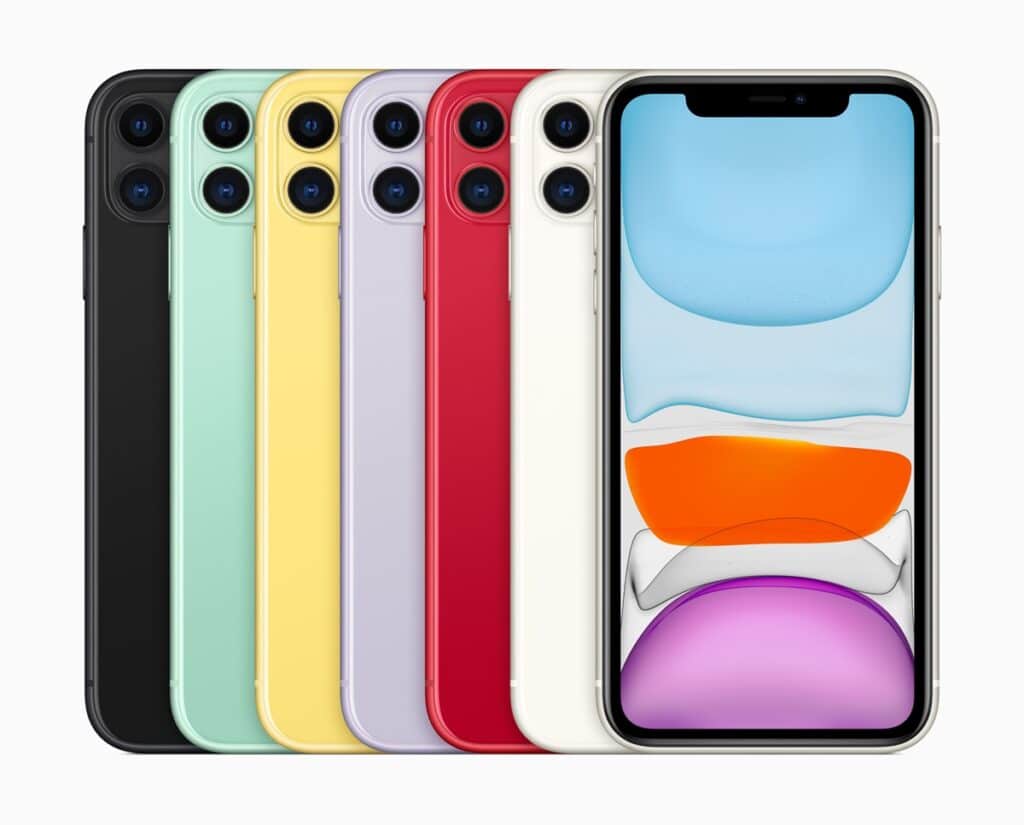
- Release date: September 20, 2019
- Models: A2111, A2223, A2221
- Storage capacity: 64GB, 128GB, 256 GB
- Major features: New U1 chip, faster FaceID, Spatial audio, dual-camera system, Night mode for photos, A13 Bionic chip, an entire day on a single charge, improved water resistance, available in six colors, price drop, 12MP TrueDepth camera, front camera 1080p HD video recording at 25 fps, 30 fps, or 60 fps, front camera 4K video recording at 24 fps, 25 fps, 30 fps, or 60 fps, next‑generation Smart HDR for photos, front camera 4K Cinematic video stabilization, QuickTake video, Wi-Fi 6, iOS 13
In 2019, before the pandemic, Apple released the iPhone 11 with significant hardware and software improvements. Compared to its predecessor, the iPhone Xr, the iPhone 11 was released with many improvements to the rear and front cameras.
The iPhone 11 was updated with the dual-camera system, previously only included in premium iPhone models such as the iPhone Xs and Xs Max.
Apple also introduced a new Night mode feature, starting with the iPhone 11. This feature detects low-light environments and turns on automatically when taking pictures.
The Facetime TrueDepth camera also received a huge upgrade. The front camera was upgraded to a 12-megapixel camera with 4K video recording and 4K Cinematic video stabilization.
Apple claims the iPhone 11 will last a day on a single charge. It also became available in six colors, including purple, green, yellow, black, white, and red. The new, improved iPhone 11 came with a price drop of $50, with a starting price of $699. Starting with this phone, Apple discontinued the 3D Touch feature introduced in the iPhone 6s.
iPhone 11 Pro & iPhone 11 Pro Max – 2019
Apple replaced the “S” moniker with “Pro” from now on. It also introduced the first iPhone with a Super Retina XDR display and the new triple camera system.
iPhone 11 Pro
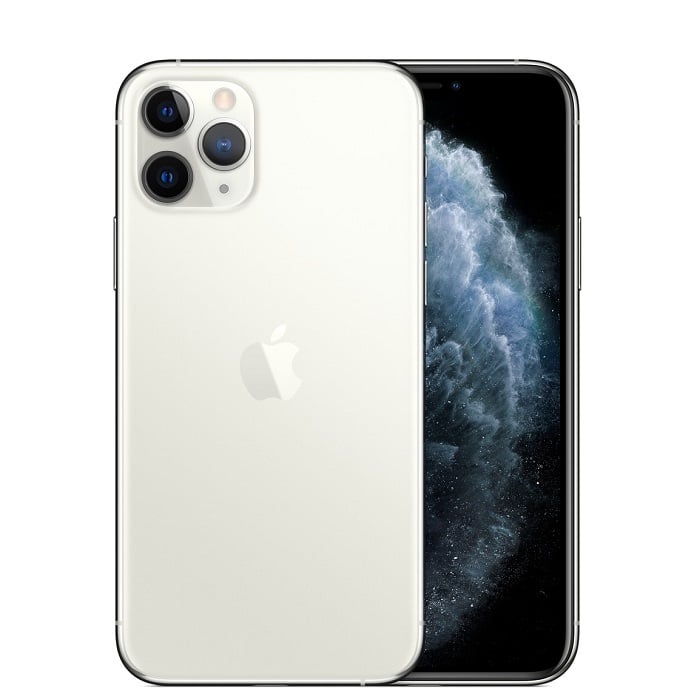
- Release date: September 20, 2019
- Models: A2160, A2217, A2215
- Storage capacity: 64GB, 256GB, 512GB
- Major features: Super Retina XDR, A13 Bionic chip, new triple-camera system, improved water resistance, four more hours of battery life
Just like the iPhone 11 received huge internal hardware upgrades, the new iPhone 11 Pro received many improvements that truly differentiated from the regular iPhone 11.
Apple introduced its new three-camera system with the iPhone 11 Pro and 11 Pro Max. This new three-camera system consisted of an Ultra Wide, Wide, and Telephoto camera. While designed nearly identical to the iPhone Xs, the iPhone 11 Pro now included a new display named the Super Retina XDR by Apple’s marketing department.
Another noticeable improvement Apple made with Pro models was in its water resistance capability. You could now submerge the iPhone 11 Pro up to 4 meters deep in water for up to 30 minutes. This is two more meters than the regular iPhone 11 and its predecessor, iPhone Xs.
The battery on the iPhone 11 Pro was also improved over the one in the iPhone Xs by four more hours of usage.
The iPhone 11 Pro and 11 Pro Max shortly became the top phones on the Consumer Reports top smartphone list.
iPhone 11 Pro Max
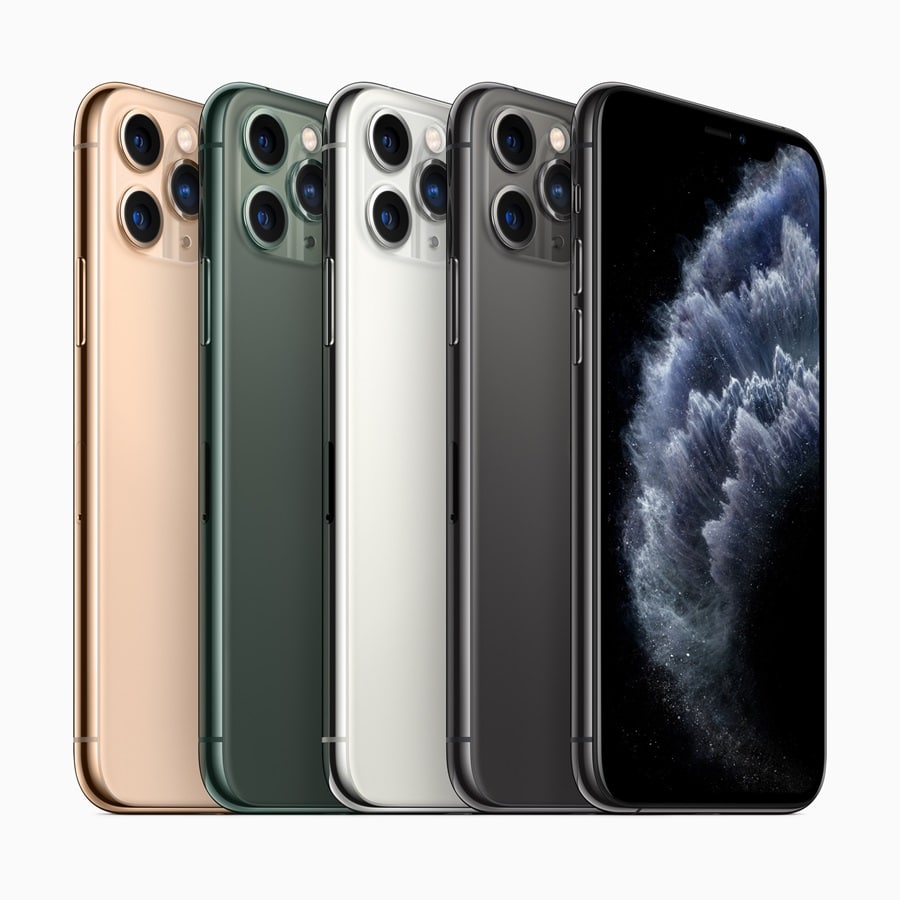
- Release date: September 20, 2019
- Models: 64GB, 256GB, 512 GB
- Storage capacity: A2161, A2220, A2218
- Major features: 5 more hours of battery life over Xs Max, two more hours over 11 Pro
Other than the size of the screen, there’s not much of a difference between the iPhone 11 Pro and Pro Max. The 11 Pro Max gives you two additional hours of video playback compared to the 11 Pro.
Compared to its predecessor, the iPhone Xs Max, the 11 Pro will give you five additional hours of battery life.
iPhone SE (2nd generation) – 2020

- Release date: April 24, 2020
- Models: A2275, A2298, A2296
- Storage capacity: 64GB, 128GB, 256GB
- Major features: 4.7-inch Retina display, budget iPhone, A13 Bionic chip, improved single-camera system, water resistance rating of IP67, Portrait mode and Smart HDR photos, Dolby Vision and HDR10 playback, Haptic Touch, Home button, wireless charging, fast-charging, Wi-Fi 6 and Gigabit-class LTE, Dual SIM (with eSIM)
In April 2020, when all other tech companies were panicking and laying off employees due to the pandemic, Apple released the 2nd gen iPhone SE. Although the iPhone SE is Apple’s budget iPhone, the 2nd gen iPhone SE came with nearly every feature in upper premium iPhone models.
The 2nd gen iPhone SE was released right when millions of people were laid off. Apple released this budget phone at the right time as people weren’t certain of their future economic situation.
Apple made a “throwback Thursday” four years after releasing the original iPhone SE by releasing the 2nd gen iPhone SE.
The updated iPhone SE was a mix of older and newer iPhones. Apple developed the iPhone SE with an iPhone 8 design but with the internal hardware found in newer iPhones such as the iPhone 11 and 11 Pro.
Since the iPhone SE 2 had an iPhone 8 body, it had older features such as Touch ID and a Home button. All these new features were powered by the A13 Bionic chip found in the iPhone 11 and 11 Pro. Overall, it was a massive improvement over the original iPhone SE from 2016.
iPhone 12 & iPhone 12 mini – 2020
It seems that the pandemic made Apple addicted to releasing phones in 2020. The company released five different devices in 2020, something never seen before.
By releasing five different devices in 2020, Apple was most likely trying to capitalize on money the government was handing out like candy to people on unemployment.
iPhone 12
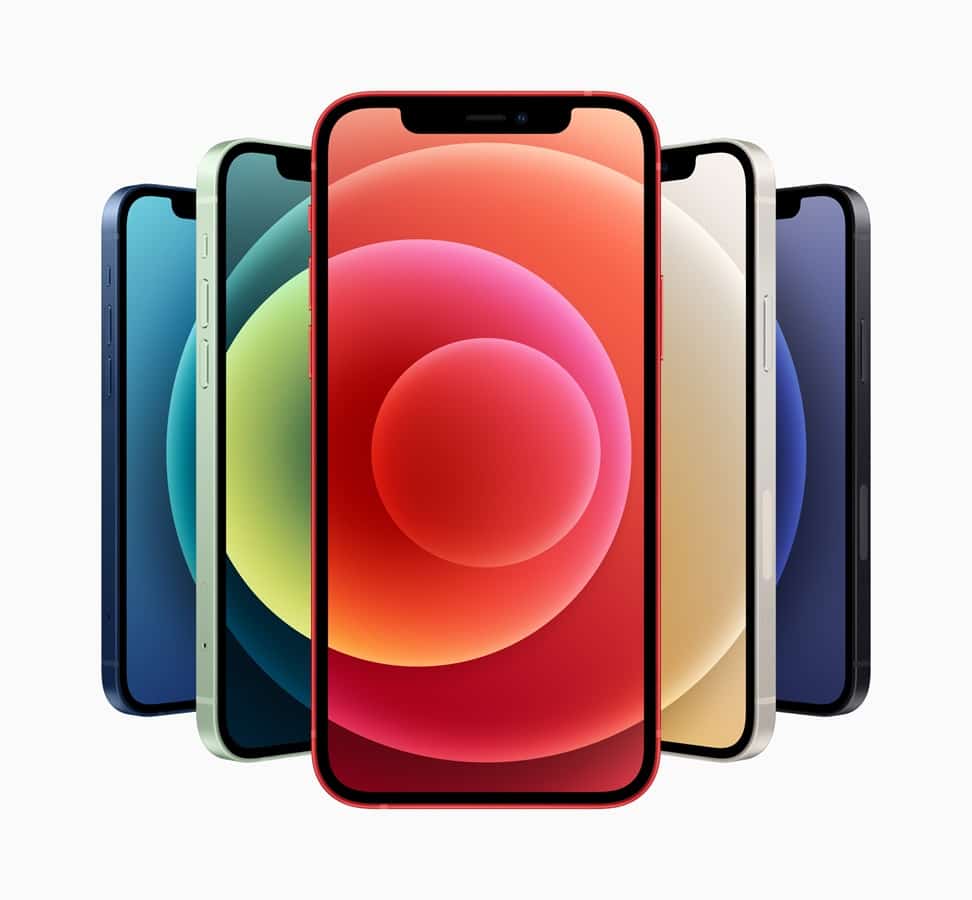
- Release date: October 23, 2020
- Models: A2172, A2402, A2404, A2403
- Storage capacity: 64GB, 128GB, 256GB
- Major features: A14 Bionic chip, 5G connectivity, 6.1-inch Super Retina XDR display, new Ceramic Shield front cover, MagSafe, Smart Data mode, improved water resistance, improved dual camera system, Smart HDR 3, iOS 14
While the iPhone 12 did not have huge upgrades like previous models, it was introduced with prominent features. The iPhone 12 now had Apple’s most powerful chip, the A14 Bionic. Apple also added a 5G modem to the iPhone 12 as carriers rushed to deploy 5G towers across the US.
As for the design, the iPhone 12 shares the same design as the iPhone 11. This time, Apple added a Ceramic Shield to protect the screen from scratches and drop damage.
One of the major complaints about the iPhone 11 was its 720p LCD screen. Apple upgraded the iPhone 12 to an OLED screen with a 2532‑by‑1170-pixel resolution.
Apple also introduced MagSafe for the iPhone. Additionally, the iPhone 12 could now last 30 minutes under 6 meters (19.6 ft) of water, compared to just two meters (6 ft) on the iPhone 11.
Another thing iPhone 12 owners were not happy to find out was that iPhones no longer came with a power adapter or the famous Apple Earbuds. Apple made this move to reduce environmental waste.
In September 2023, France banned the sale of the iPhone 12 because it “emitted too much radiation.” Apple later fixed this problem with the release of iOS 17.1.
iPhone 12 mini
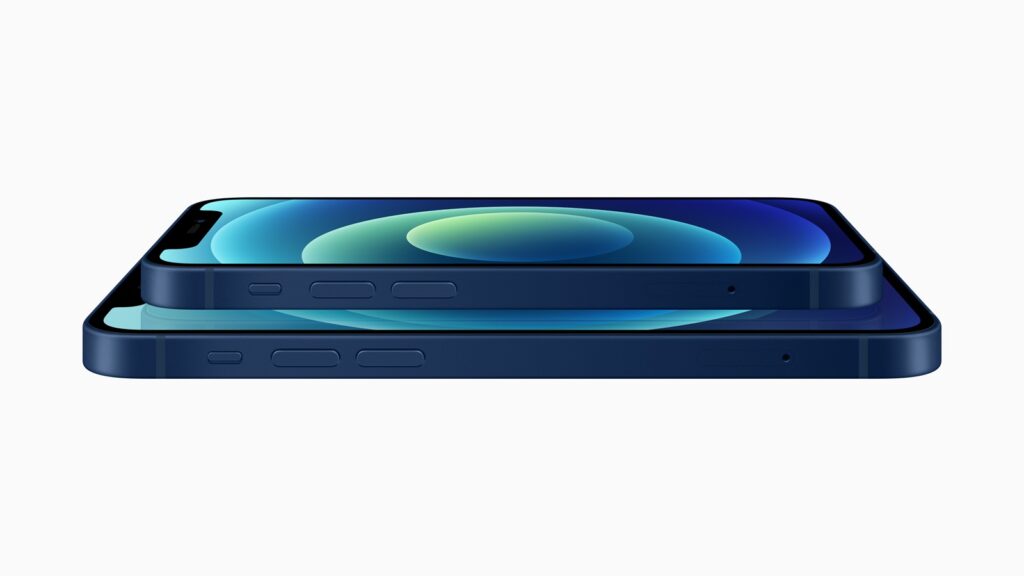
- Release date: November 13, 2020
- Models: A2176, A2398, A2400, A2399
- Storage capacity: 64GB, 128GB, 256GB
- Major features: 5.4-inch, cheaper than the iPhone 12
Along with the iPhone 12, Apple announced its smaller brother, the iPhone 12 mini. The iPhone 12 mini was Apple’s answer for those missing smaller phone sizes but not wanting to be mixed with the low-budget crowd.
The iPhone mini was a new iPhone model. But don’t get it wrong! Although the iPhone 12 mini was a smaller version of the iPhone 12, it was not a budget phone. Unlike the iPhone SE, the iPhone 12 mini was built with all the features and components of higher-end iPhone models. It has the same design, cameras, and chip featured in the iPhone 12.
The only downside of the iPhone 12 mini over the regular iPhone 12 is its shorter battery life due to its size.
Apple’s budget iPhone, the iPhone SE, starts at $399, while the 12 mini starts at $699. Unfortunately, shortly after its release, reports showed that 12 minis were not selling that well. This led Apple to cut iPhone 12 mini production by 20%, as reported by CNBC.
iPhone 12 Pro & iPhone 12 Pro Max – 2020
The iPhone 12, 12 mini, and 12 Pro series were the first iPhones with 5G connectivity, Ceramic Shield, and MagSafe. They also no longer came with a power adapter and Earbuds.
iPhone 12 Pro
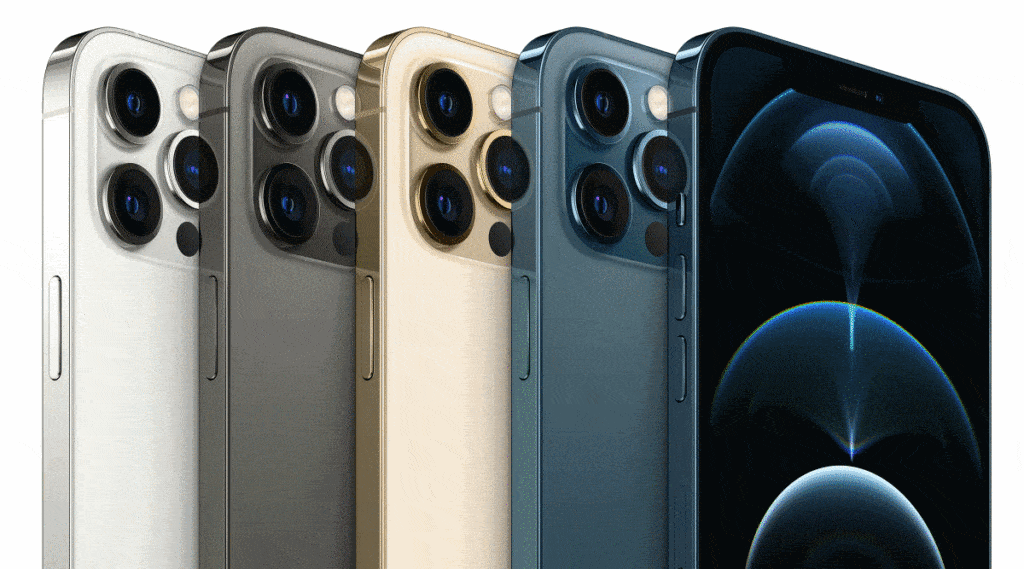
- Release date: October 23, 2020
- Models: A2341, A2406, A2408, A2407
- Storage capacity: 128, 256, 512 GB
- Major features: Refreshed design, Apple ProRAW, LiDAR Scanner, 6.1‑inch OLED display, Ceramic Shield front cover, A14 Bionic chip, 5G connectivity, MagSafe, Smart Data mode, improved water resistance, Smart HDR 3, iOS 14
With the iPhone 12 lineup, Apple refreshed the iPhone with a squarish design similar to the iPhone 4 and 5. The newly reshaped iPhone 12 Pro now featured a 6.1-inch OLED display, bigger than the 5.8-inch screen of the iPhone 11 Pro.
As a new feature, the iPhone 12 Pro now has a photo format called ProRaw, which gives you the raw files of every picture. It also introduced the LiDAR Scanner for better pictures, augmented reality apps, and games.
Like the iPhone 12 lineup, the iPhone 12 Pro could now last up to 30 minutes under six meters of water.
Unlike the 11 Pro, Apple stopped selling 64GB Pro models, starting with the iPhone 12 Pro. The storage capacity for the Pro models now starts at 128GB.
iPhone 12 Pro Max

- Release date: November 13, 2020
- Models: A2342, A2410, A2412, A2411
- Storage capacity: 128GB, 256GB, 512 GB
- Major features: Longer telephoto lens, 6.7-inch OLED Super Retina XDR display, 2.5x optical zoom in, up to 12x digital zoom, refreshed design, Apple ProRAW, LiDAR Scanner, Ceramic Shield front cover, A14 Bionic chip, 5G connectivity, MagSafe, Smart Data mode, improved water resistance, Smart HDR 3, iOS 14
Like the iPhone 12 Pro, the 12 Pro Max also received a bigger screen upgrade. Apple jumped from a 6.5‑inch iPhone 11 Pro Max screen to a 6.7-inch display on the 12 Pro Max. It also features a longer 65mm telephoto lens than the 12 Pro.
The iPhone 12 Pro Max was released on November 13, 2020, along with the iPhone 12 mini.
iPhone 13 & iPhone 13 mini – 2021
iPhone 13

- Release date: September 24, 2021
- Models: A2482, A2631, A2634, A2635, A2633
- Storage capacity: 128GB, 256GB, 512GB
- Major features: Redesigned rear dual-camera system, improved TrueDepth front camera, Smart HDR 4, A15 Bionic chip, more 5G bands, longer battery life, improved Super Retina XDR display, 128GB base storage, iOS 15
Of the few improvements the iPhone 13 had over the iPhone 12, the rear and TrueDepth camera system were the most notable.
The new dual-camera system was diagonally arranged compared to the vertical position on the iPhone 12. Apple also made the TrueDepth camera even smaller in the iPhone 13.
Apple was also able to increase the battery life of the iPhone 13 by two and a half hours. This was accomplished thanks to a more power-efficient A15 chip and a larger battery. Within the regular 12 models, 128GB is now the base storage; 64 GB is a thing of the past.
iPhone 13 mini
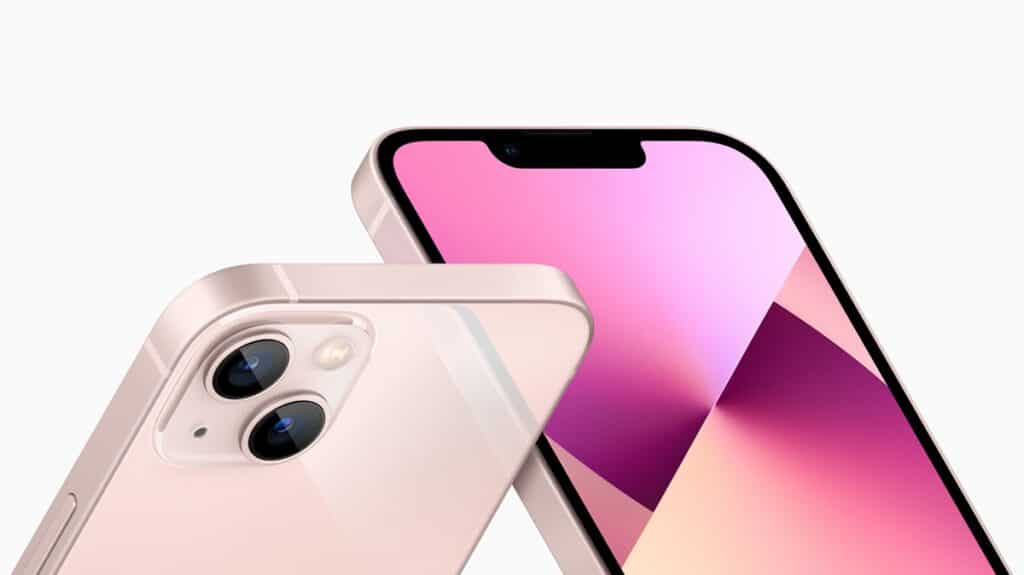
- Release date: September 24, 2021
- Models: A2481, A2626, A2629, A2630, A2628
- Storage capacity: 128GB, 256GB, 512GB
- Major features: 5.4-inch display, redesigned rear dual-camera system, improved TrueDepth front camera, Smart HDR 4, A15 Bionic chip, more 5G bands, longer battery life, improved Super Retina XDR display, 128GB base storage, iOS 15
The battery lasts an hour and a half more than the iPhone 12 mini.
iPhone 13 Pro & iPhone 13 Pro Max
The first iPhones with ProMotio (120Hz) and 1TB of storage.
iPhone 13 Pro

Release date: September 24, 2021
Models: A2483, A2636, A2639, A2640, A2638
Storage capacity: 128GB, 256GB, 512GB, 1TB
Major features: 120Hz display (ProMotion), new camera system, 1TB storage, ProRes codec, improved TrueDepth front camera, Smart HDR 4, A15 Bionic chip, more 5G bands, longer battery life, iOS 15
While 120hz on display was something Android users had been enjoying for years, Apple introduced 120Hz with the iPhone 13 Pro in 2021 for the first time.
Apple’s marketing department decided to call this the Super Retina XDR display with ProMotion. This allows smoother scrolling on the iPhone.
With the iPhone 13 Pro, Apple improved its three rear cameras. The Telephoto camera now has a ƒ/2.8 aperture lens, the Wide camera is now ƒ/1.5 aperture, while the Ultra Wide is ƒ/1.8 aperture.
Apple improved the battery life by one hour compared to the iPhone 12 Pro. They also nearly doubled the storage by offering a 1TB iPhone for the first time.
iPhone 13 Pro Max

Release date: September 24, 2021
Models: A2484, A2641, A2644, A2645, A2643
Storage capacity: 128GB, 256GB, 512GB, 1TB
Major features: 6.7‑inch, 120Hz display (ProMotion), new camera system, 1TB storage, ProRes codec, improved TrueDepth front camera, Smart HDR 4, A15 Bionic chip, more 5G bands, longer battery life, iOS 15
Other than the screen size, there aren’t any major differences between the iPhone 13 Pro and the iPhone 13 Pro Max. The only smaller but noticeable difference is the battery life. The iPhone 13 Pro Max can last up to 28 hours of video playback, while the regular 13 Pro can only last up to 22 hours.
Compared to the previous iPhone 12 Pro Max, the 13 Pro Max lasts eight more hours of video playback.
iPhone SE (3rd generation) – 2022
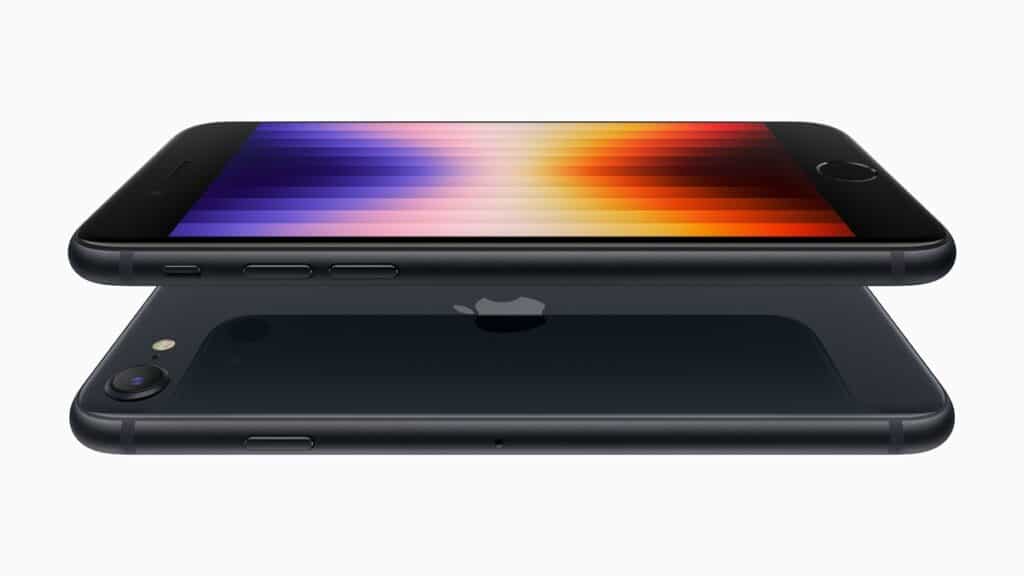
Release date: March 18, 2022
Models: A2595, A2782, A2784, A2785, A2783
Storage capacity: 64GB, 128GB, 256GB
Major features: A15 Bionic chip, 5G connectivity, longer battery life, Smart HDR 4, camera improvements, iOS 15
Nearly two years after releasing the 2nd gen iPhone SE, Apple released the third-gen iPhone SE as the world was starting to be relieved from the pandemic.
Since the iPhone SE is a budget iPhone, it did not come with new groundbreaking features. This is something to be expected.
The new 3rd-generation iPhone SE had many new features and hardware improvements introduced in the previously released iPhone 13. The iPhone SE included the latest A15 chip, 5G connectivity, and improved cameras.
Additionally, due to the enhanced battery and the efficiency of the A15 chip, the 3rd-gen iPhone SE lasts two more hours of video playback than the 2nd-gen iPhone SE, lasting up to 15 hours.
Shortly after the iPhone SE 3 was released, it was reported that Apple reduced production due to weak sales.
iPhone 14 & iPhone 14 Plus – 2022
Apple returned to the pre-iPhone X era and started having a Plus version of the regular iPhone.
iPhone 14
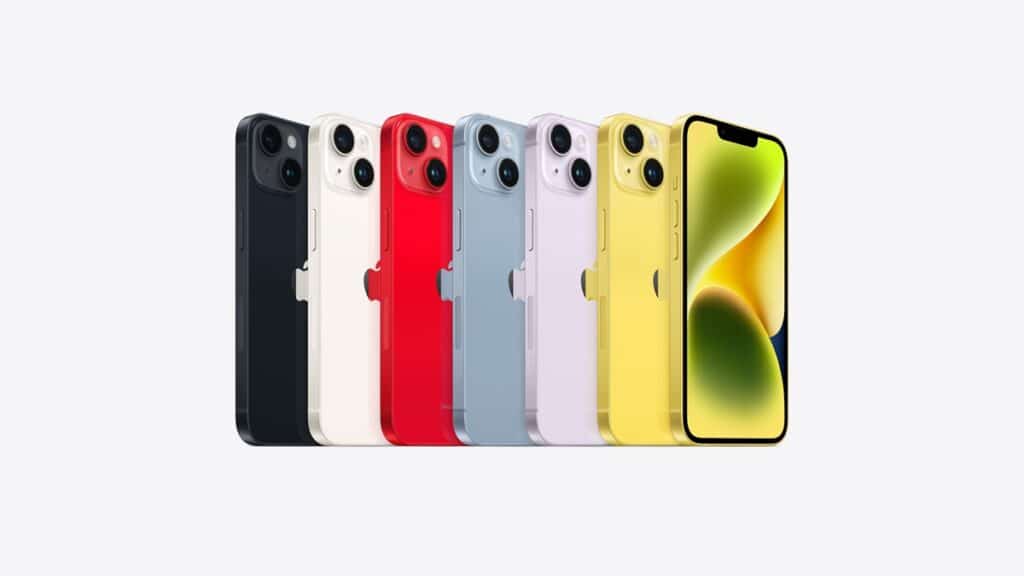
Release date: September 16, 2022
Models: A2649, A2881, A2884, A2883, A2882
Storage capacity: 128GB, 256GB, 512GB
Major features: New cameras, Photonic Engine, Cinematic mode, Crash Detection, updated internal design, Satelite Emergency SOS, No SIM Card, iOS 16
With the iPhone 14, Apple saved its flagship chip, the A16, for the iPhone 14 Pro and Pro Max. Instead, the regular iPhone 14 and 14 Plus got the A15 chip from the previous year.
Apple, this time, focused on turning the iPhone into a superhero who saves a life. The iPhone maker packed the iPhone 14 with a new Crash Detection feature. The Crash Detection feature automatically calls your local emergency service when the phone detects that you’ve been in a car accident. Unexpectedly, Apple had a major problem with this feature when it was introduced: the phone was calling 911 for users riding on rollercoasters.
Additionally, Apple introduced Emergency SOS. This feature sends your emergency to an Apple emergency center via Satelite if you don’t have cellular coverage. An Apple agent then passes down your emergency to the closest emergency service on your behalf.
Internally, Apple eliminated the use of physical SIM. The phone completely relies on an internal programmable chip, eSIM, which replaces physical SIM cards.
Apple also redesigned the iPhone 14 internal architecture to improve thermal performance. This internal redesign also made the iPhone 14 easier to repair, as noted by iFixit.
iPhone 14 Plus

Release date: October 7, 2022
Models: A2632, A2885, A2888, A2887, A2886
Storage capacity: 128GB, 256GB, 512GB
Major features: 6.7-inch OLED display, new cameras, Photonic Engine, Cinematic mode, Crash Detection, updated internal design, Satelite Emergency SOS, NO SIM Card, iOS 16
With the iPhone 14 Plus, Apple put a 6.7-inch screen on a non-pro iPhone model for the first time. Thanks to its bigger size, the iPhone 14 Plus lasts six more hours of video playback than the iPhone 14.
iPhone 14 Pro & iPhone 14 Pro Max – 2022
iPhone 14 Pro
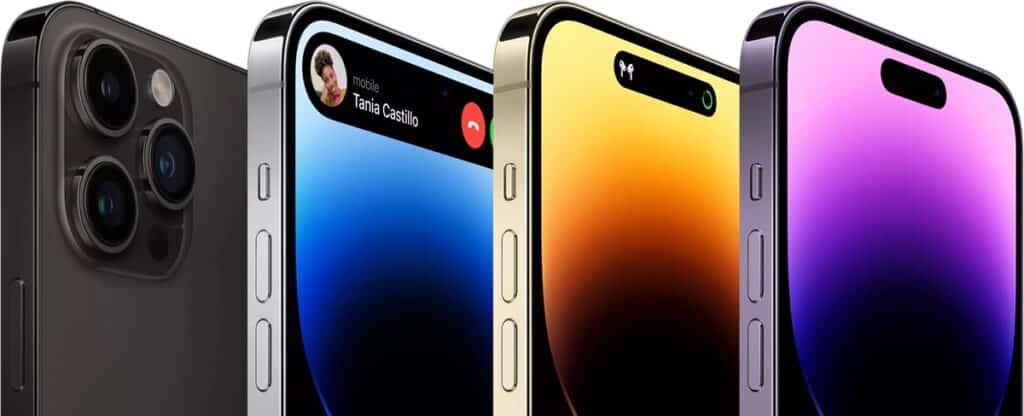
Release date: September 16, 2022
Models: A2650, A2889, A2892, A2891, A2890
Storage capacity: 128GB, 256GB, 512GB, 1TB
Major features: Dynamic Island, Always-On display, A16 Bionic chip, 48MP Main camera, Photonic Engine, Cinematic mode, Crash Detection, Satelite Emergency SOS, No SIM Card, iOS 16
Remember that notch/pill design Apple introduced with the iPhone X? Apple made that wasted space useful with the iPhone 14 Pro. With the iPhone 14 Pro lineup, Apple introduced the Dynamic Island feature. This feature displays notifications and important alerts on the iPhone’s notch, where the TrueCamera is located.
Apple also introduced the Always-On feature. This feature dims the screen of the iPhone and shows you information on the lock screen instead of putting it to sleep. This is a feature that has been on Android devices for ages. Apple introduced it on their most expensive iPhone in 2022.
Inside Apple’s 2022 flagship, the phone was upgraded to a 48MP camera and is powered by the A16 Bionic chip.
iPhone 14 Pro Max
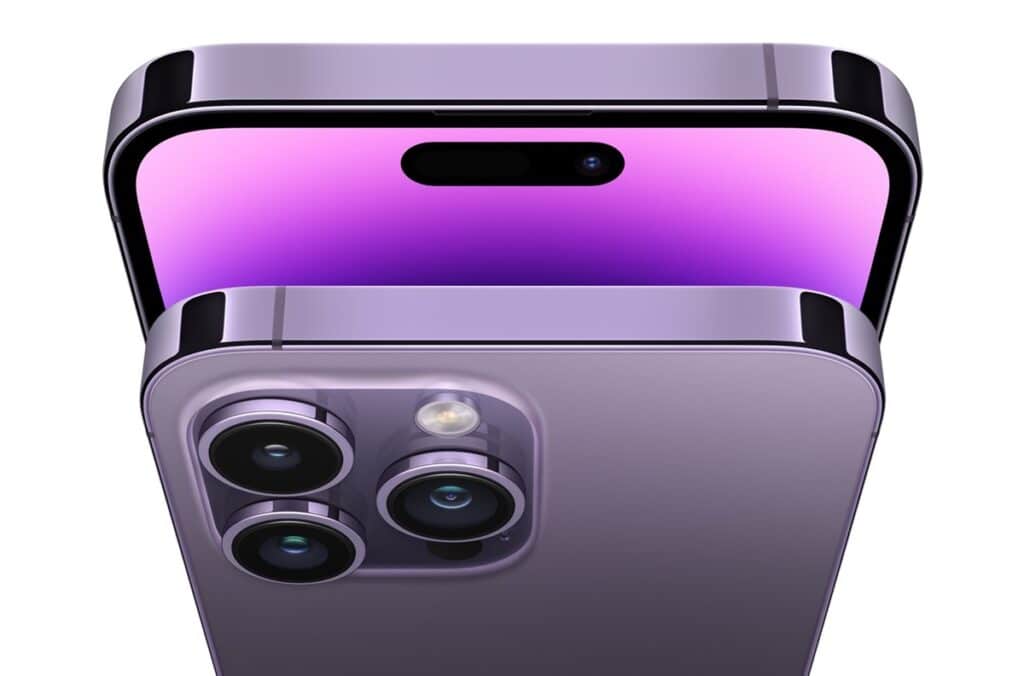
Release date: September 16, 2022
Models: A2632, A2885, A2888, A2887, A2886
Storage capacity: 128GB, 256GB, 512GB
Major features: 6.7-inch Super Retina XDR, Dynamic Island, Always-On display, A16 Bionic chip, 48MP Main camera, Photonic Engine, Cinematic mode, Crash Detection, Satelite Emergency SOS, No SIM Card, iOS 16
The iPhone 14 Pro has no exclusive features. Minus its size, the phone is the same as the iPhone 14 Pro. iPhone 14 Pro Max users, however, can enjoy up to six more hours of video playback than iPhone 14 Pro users.
iPhone 15 & iPhone 15 Plus – 2023
Apple shocked the world when it abandoned its cash cow Lightning connector, replacing it with USB-C, starting with the iPhone 15 and 15 Pro lineup.
iPhone 15
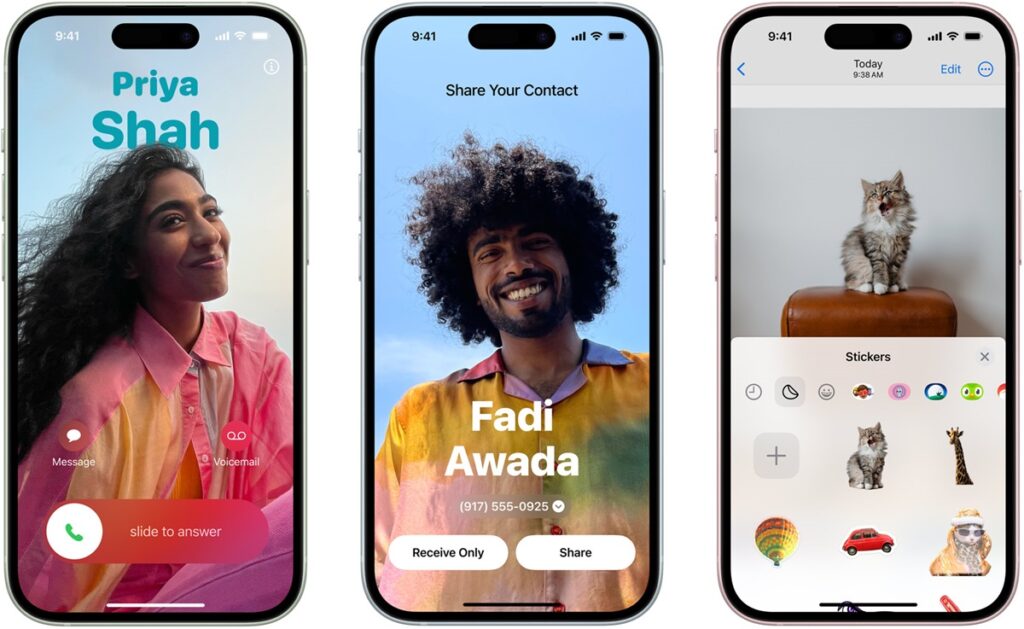
Release date: September 22, 2023
Models: A2846, A3089, A3092, A3090
Storage capacity: 128GB, 256GB, 512GB
Major features: Dynamic Island, 48MP Main camera, 2nd-gen Ultra-Wideband Chip, Satelite Roadside Assistance, USB‑C connector, Precision Finding for Find My friends, iOS 17
In 2023, Apple did not bother with the iPhone mini or SE. Instead, they simplified everything and released an iPhone 15 and the 15 Plus.
Apple brought a few features from the iPhone 14 Pro to the regular 6.1-inch iPhone 15. Like the iPhone 14 Pro, the regular iPhone 15 got upgraded to a 48MP Main camera. It also received the Dysmic Island feature introduced with the iPhone 14 Pro.
Best of all, Apple started using USB-C with the iPhone 15 as mandated by the European Union. Thanks to this, you can transfer charge from your iPhone to your AirPods or Apple Watch.
iPhone 15 Plus
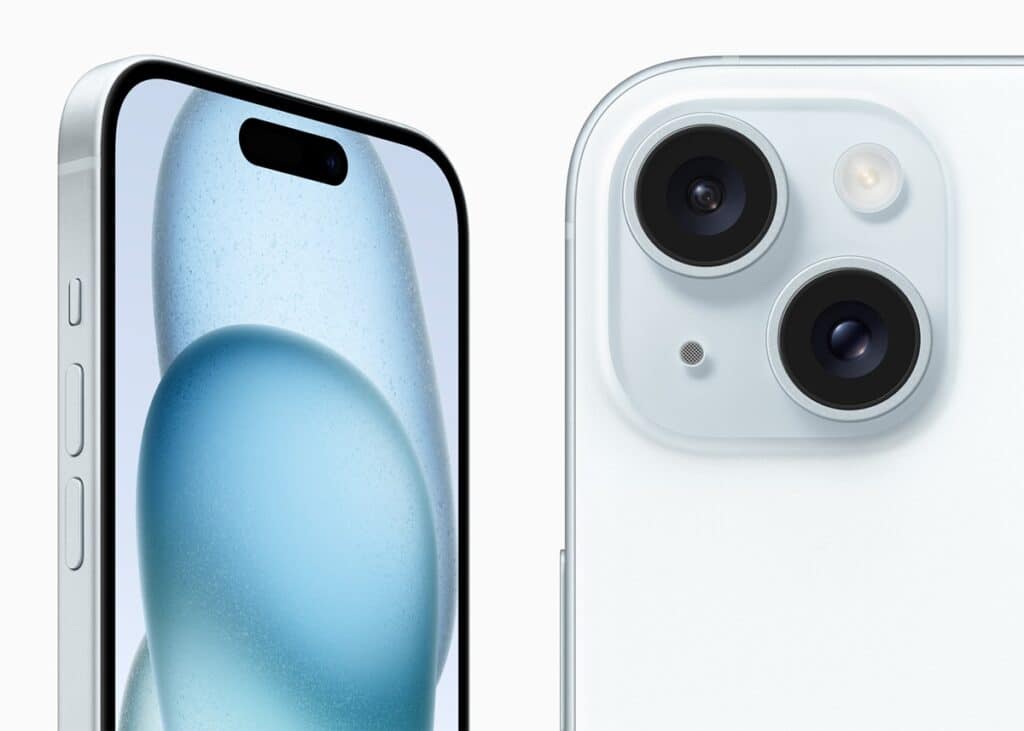
Release date: September 22, 2023
Models: A2847, A3093, A3096, A3094
Storage capacity: 128GB, 256GB, 512GB
Major features: 6.7 inch Super Retina XDR display, Dynamic Island, 48MP Main camera, Satelite Roadside Assistance, USB‑C connector, Precision Finding for Find My friends, iOS 17
The iPhone 15 Plus has the same battery capacity as its predecessor, the iPhone 14 Plus. It can last up to 26 hours of offline video playback. It’ll give you six more hours of video playback than the iPhone 15.
iPhone 15 Pro & iPhone 15 Pro Max – 2023
No more Ring/Silent switch; say hello to the Action button and titanium.
iPhone 15 Pro
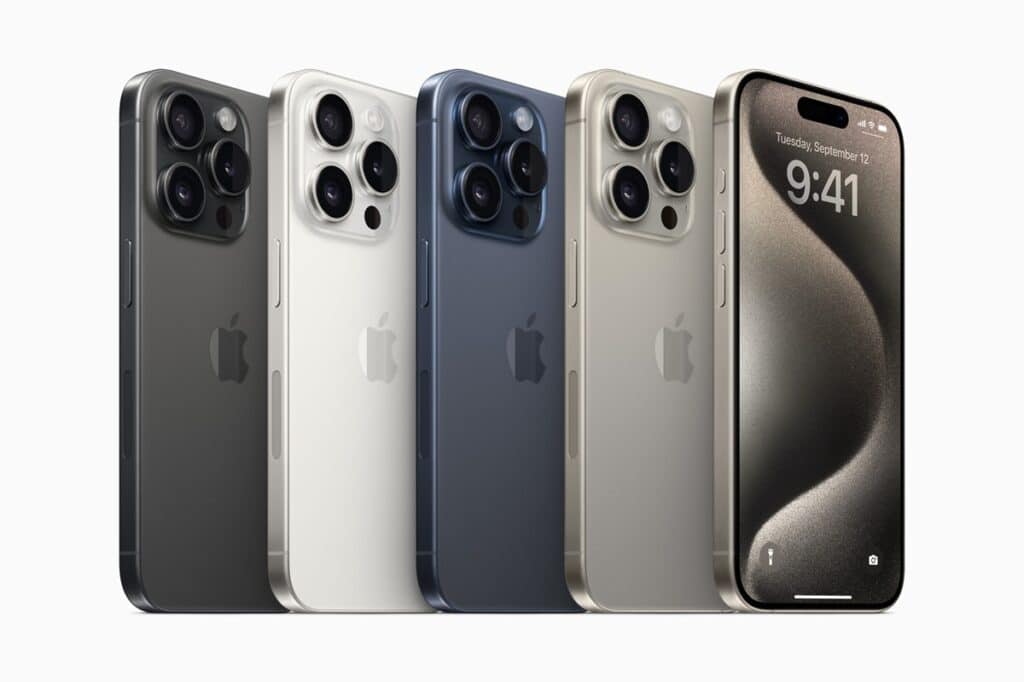
- Release date: September 22, 2023
- Models: A2848, A3101, A3104 , A3102
- Storage capacity: 128GB, 256GB, 512GB, 1TB
- Major features: Titanium design, internal redesign, Action button, camera upgrades, 20x faster USB 3 speeds, A17 Pro chip, Wi-Fi 6E, improved audio quality, 2nd-gen Ultra-Wideband Chip, Satelite Roadside Assistance, USB‑C connector, Precision Finding for Find My friends, iOS 17
With the iPhone 15 Pro lineup, Apple redesigned the iPhone 15 Pro externally and internally. Externally, Apple shocked the world by building the iPhone 15 Pro lineup of Titanium Grade 5, a metal alloy used by NASA in their rockets.
Internally, just like with the iPhone 14 and 14 Plus, Apple redesigned the architecture of the iPhone 15 Pro for easier and more affordable repairs. Additionally, the 15 Pro lineup offers faster USB-C speeds than the iPhone 15.
Apple also replaced the Silent mode switch from the iPhone 15 Pro with the Action button.
The iPhone 15 received many reports of overheating.
iPhone 15 Pro Max

- Release date: September 22, 2023
- Models: A2849, A3105, A3108, A3106
- Storage capacity: 256GB, 512GB, 1TB
- Major features: 5x Telephoto camera, 6.7-inch display, Titanium design, internal redesign, Action button, camera upgrades, 20x faster USB 3 speeds, A17 Pro chip, Wi-Fi 6E, improved audio quality, 2nd-gen Ultra-Wideband Chip, Satelite Roadside Assistance, USB‑C connector, Precision Finding for Find My friends, iOS 17
The iPhone 15 Pro Max has the same battery capacity as the iPhone 14 Pro Max, lasting up to 29 hours of video playback. It can last up to six more hours than the 15 Pro.
